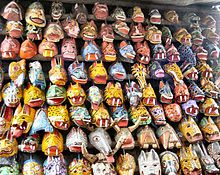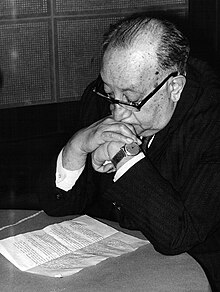Literature of Guatemala
The literature of Guatemala is the (by far predominantly) Spanish-language literature of Guatemala . Their themes are largely determined by the history and politics of the most populous country in Central America with around 17 million inhabitants: civil war and dictatorship, violence by landowners and military, guerrillas and exile, but also religion, myths and the oppression of the descendants of the Maya take up a large part. In the course of the urbanization process, urban topics as well as action and crime literature have recently become more important.

Indigenous traditions
In the literature of Guatemala the traditions of the Maya, who still suffer from marginalization and discrimination today, are still alive. However, numerous Maya codices were destroyed by the Spanish. The myths and songs of the collection of Francisco Ximénez received Popol Vuh , which from the perspective of Quiché reported among others, the creation of the world, appeared in various translations and adaptations. A dance drama rediscovered in 1856, the so-called Rab'inal Achí ballet - probably dating from the 15th century - was passed down orally in the Maya language and later written down in Latin. It represents a conflict between the Achí and the Quiché and is now regularly performed with musical accompaniment in the Achí language in Rabinal .
In addition to Quiché, Achí and other Mayan languages , Nahuatl and Nawat (Pipil) were also common as lingua franca in the past .
Early writers
The fables of Rafael García Goyena (1766–1823), who was involved in the independence movement and barely escaped death, come from the colonial era . José Milla y Vidaurre (1822–1882), a conservative representative of Costumbrismo , wrote the first historical novels in Guatemala. A well-known representative of the modernism founded by Rubén Darío and oriented towards Europe was the scandalous prose author and journalist Enrique Gómez Carrillo (1873–1927), who lived in Paris for a long time, traveled to Russia and the Far East and translated books from Japanese. In Guatemala, however, he was attacked for his support for the dictator Manuel José Estrada Cabrera and was later forgotten.
The so-called Generation 1910 included the post-modernist novelist, narrator and poet Rafael Arévalo Martínez (1884–1973), who dealt with current political problems for the first time in his work in a satirical and alienated form, and Carlos Wyld Ospina (1891–1956), who in his 1940 The novel "Paw and Swing" ( La gringa ), translated into German, described the exploitation of the Indians under the dictatorship of Cabrera and in the face of an authoritarian society dominated by semi-feudal structures and the United Fruit Company.
Magical realism and surrealism
The outstanding writer of Guatemala and Central America is Miguel Ángel Asturias (1899–1974), the most important representative of the 1920 generation . He was influenced by surrealism . He also fought against Cabreras; he had to emigrate twice. He translated the Popol Vuh into Spanish. Among his best known works are the "Legends from Guatemala" ( Leyendas de Guatemala ). In the so-called banana trilogy, Asturias describes the exploitation of the Central American countries by the all-powerful banana companies; "Storm" ( Viento fuerte ); “The Green Pope” ( El papa verde ); "The eyes of the buried" ( Los ojos de los enterrados ). In 1966 Asturias received the Lenin Prize and in 1967 the Nobel Prize for Literature .

In 1954, after a ten-year phase of democratization, a military dictatorship was established at the instigation of the USA. This led to the civil war after 1960, which was not at least formally ended until 1966. Many intellectuals and artists were persecuted during this time and went into exile in Mexico. In addition to Miguel Ángel Asturias and Luis Cardoza y Aragón, the poets and essayists Carlos Illescas (1918–1998) and Luis Cardoza y Aragón (1901–1992) as well as the novelist, narrator and essayist Mario Monteforte Toledo (1911–2003), the one Was an admirer of Mayan culture and wrote his works partly from an indigenous perspective.
For many authors, exile led to an increase in literary quality and changed narrative forms and perspectives, but political themes were retained. Younger authors emigrated to El Salvador more often.
The overthrow of reform president Jacobo Arbenz by the US State Department, the CIA and the United Fruit Company describes Asturias in the work Week-end in Guatemala . In Hombres de maíz ("Corn People"), magical realism is a constituent design element. Asturias renounces the development of an indigenous perspective; for him, the fight against neocolonialism and for social modernization are in the foreground.
Under the surrealist influence of v. a. by Jorge Luis Borges and Franz Kafka there is also the prose by Augusto Monterroso (1921–2003). He is the author of elaborate microrrelatos ( short stories ), which sometimes only consist of a single set of boxes. Monterrosso lived outside Guatemala for most of his life, worked for Pablo Neruda in Chilean exile and died in Mexico.
In 1978 Max Araujo founded the group RIN 78 , to which u. a. the literary scholar and critic Francisco Albizúrez Palma (1938-2016) and the literary scholar and narrator Dante Liano (* 1948) belonged. Several of its members were also persecuted and had to go into exile. Liano received the National Literature Prize in 1991.
Poetry
The volume of poetry "Even under the bitterness" ( Informe de una Injusticia ) by Otto René Castillo (1936–1967), who was brutally murdered by the military , is well known; many people can quote the poems by heart. He uses simple contrasts to poetically translate the social tensions. The publication of “Poems of the Erotic Left” by Ana María Rodas (* 1937) caused a scandal in 1973 . The poet Isabel de los Ángeles Ruano (* 1945) now lives as a man and works as a traveling salesman. In 2001 she received the National Prize for Literature.
Modern times
Urban issues have been in the foreground since the 1990s, but these are closely interwoven with the political situation: the problems of youth, gang wars, the disappearance of many people without a trace, family conflicts. Consequently, the novelist Mario Roberto Morales (* 1947) not only calls for a departure from the idyll of magical realism and Macondismo , which ignores the traces of colonialism, but also for a consistent desmacondización .
Arturo Arias (* 1950), who now lives in the USA, deals with questions of time in his novels and essays. Franz Galich (1951–2007), who later emigrated to Nicaragua, wrote his first novel in 1995 about the 1976 earthquake that devastated the country and its social consequences. Rodrigo Rey Rosa (* 1958), perhaps the most important author in Guatemala at the moment, emigrated in 1979, spent many years in Europe and the USA as well as in Morocco and returned in the 1990s. He writes short prose and novels focused on action and suspense that deal with the difficult life in Latin American cities. His detective novel Los sordos (2012) ( Eng . "The Deaf", 2016) deals with the conflicts between the judicial system and the Mayan vigilante justice.
Eduardo Halfon (* 1971), who now lives in the United States, is one of the well-known storytellers . Javier Payeras (* 1974) is the author of short stories and novels with a distinctly autobiographical impact ( Ruido de fondo 2003) as well as essays. Arnoldo Gálvez Suárez (* 1982) writes short stories and detective novels as well as screenplays.
The most important literary prize in Guatemala is the Premio Nacional de Literatura de Guatemala "Miguel Ángel Asturias" , which has been awarded since 1988.
Indigenous literature
The indigenous author Luis de Lion (also: Luis de Lión or de León; * 1940) was murdered by the secret service in 1984. In Quiché , the indigenous writer Humberto Ak'abal (* 1952), who grew up among farm workers, writes (“The Weeping of the Jaguar”, German 2005).
Individual evidence
- ^ Michael Rössner: Latin American literary history. Springer, 2016, p. 285 f.
- ^ Michael Rössner: Latin American literary history. Springer, 2016, p. 288 ff.
- ↑ Nadine Haas: Literature and Urban Violence in Guatemala. Dissertation, Hamburg 2012. PDF
- ↑ Frank Tichy: Guatemala: Paradise and Inferno. Book on Demand 2011, ISBN 978-3-8423-9661-6 , p. 55 ff.
- ^ Klaus Küpper: Invitation to a journey of discovery. In: ILA. The Latin America magazine. No. 331, December 2009, pp. 40-44.
- ^ Mario Roberto Morales: La 'desmacondización' de América Latina , in: voltairenet.org, May 20, 2002.
- ↑ Info on www.literaturfestival.com
literature
- Francisco Albizúrez Palma, Carlos Barrios y Barrios: Historia de la literatura guatemalteca. 2 volumes, Guatemala City 1981.


